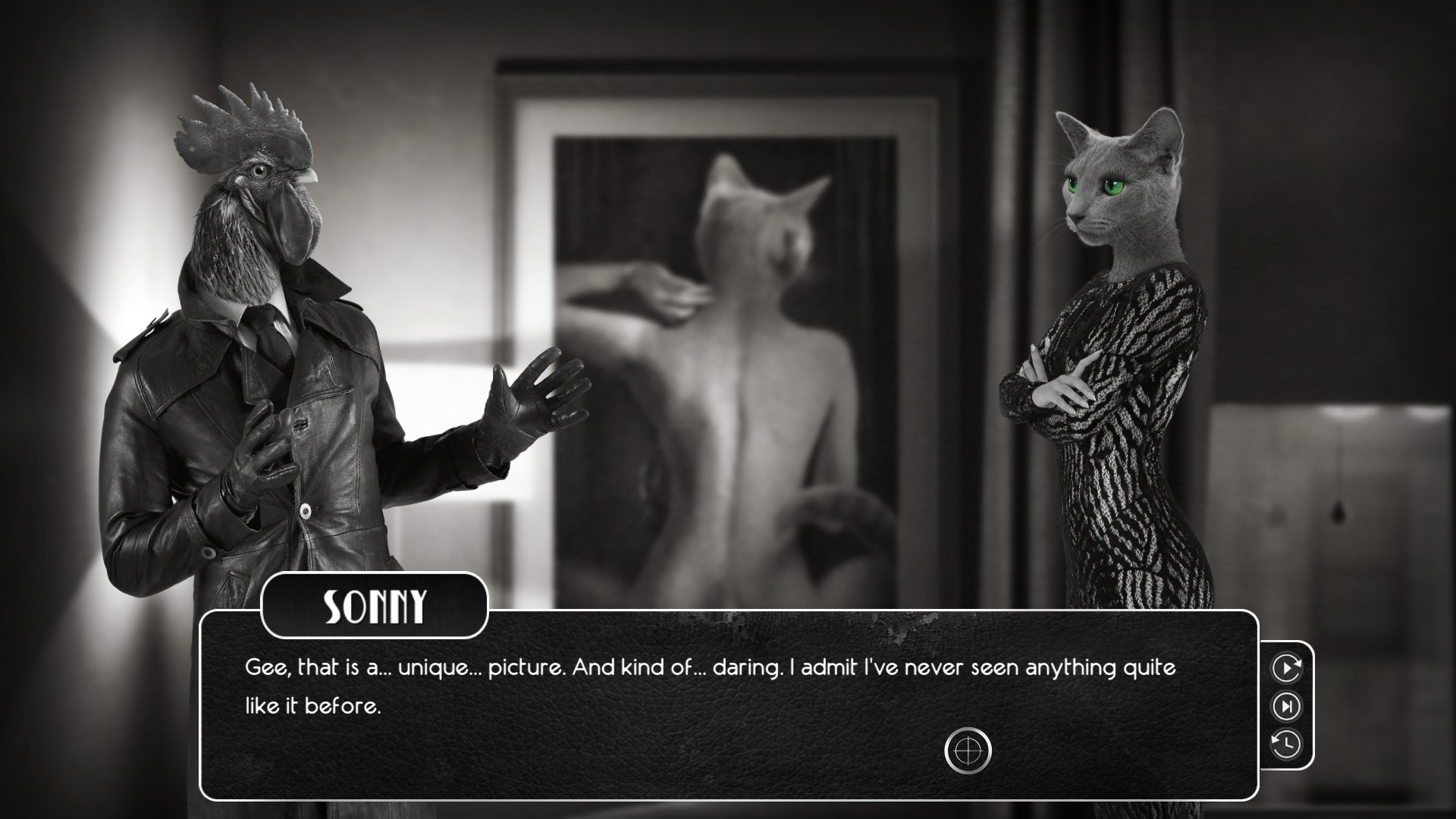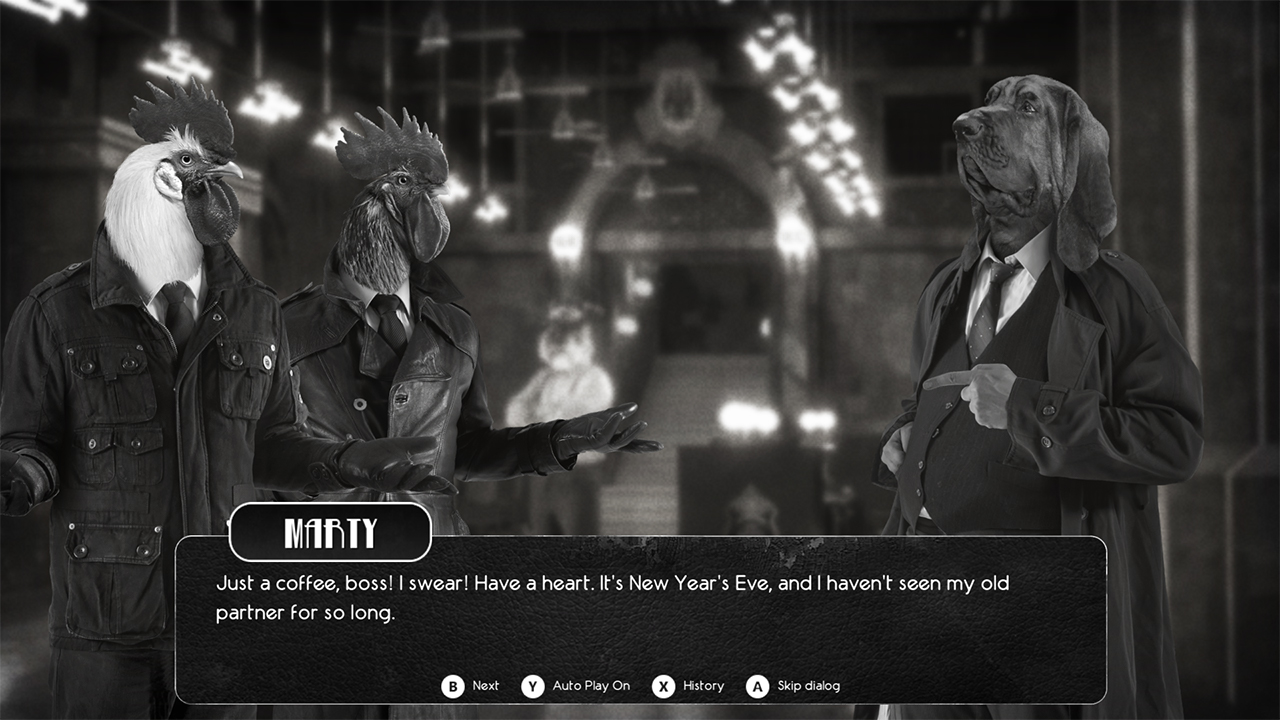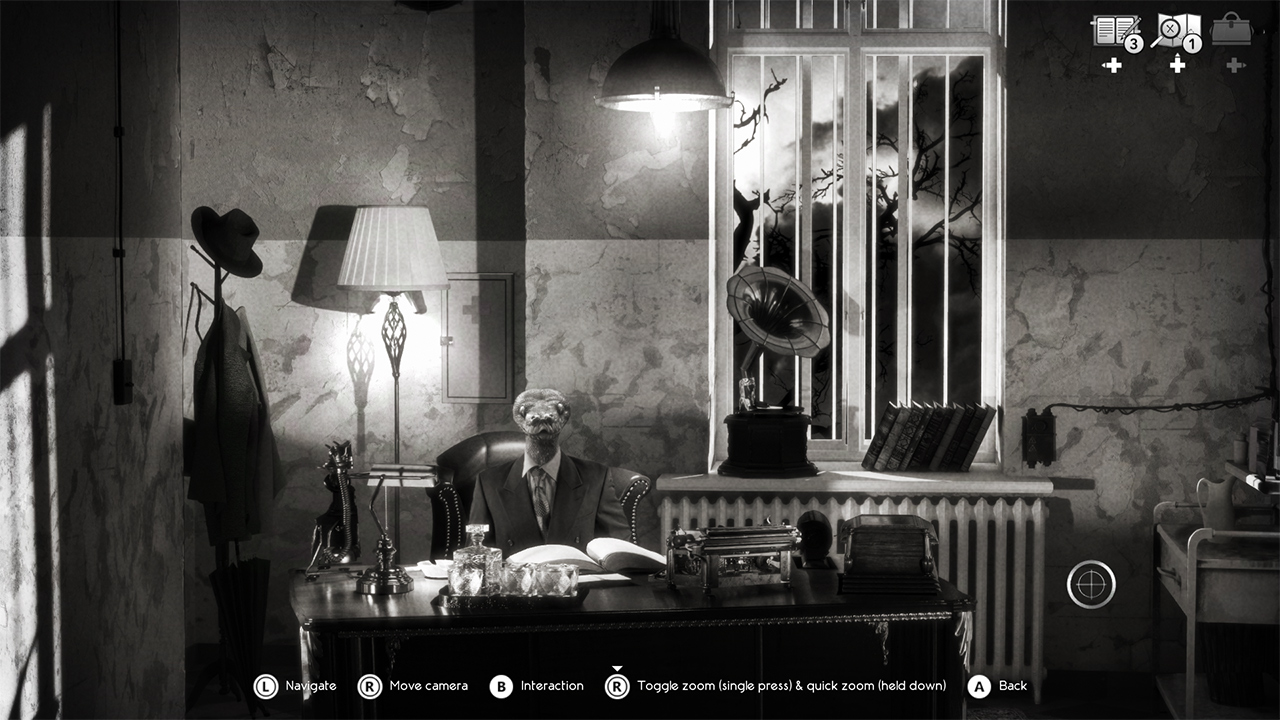Murder most fowl.
If there’s a 2020 game award for Most Literal Title, Chicken Police – Paint it RED would certainly get a nomination. This is a game about chickens who are police. Specifically, two chickens: Sonny Featherland and Marty MacChicken.
Well, except they’re not entirely chickens; they’re chicken heads on human bodies. All of the game’s characters are anthropomorphic animals of varying degrees, giving it an instantly striking look. This is backed by the gritty, black-and-white presentation of a cinema noir film. Even there, some color is used to striking effect, such as bright green eyes or dark red blood. Chicken Police wants to set a mood, and it does that very well.
The presentation accents a detective story centered around love, betrayal, money, power, and (of course) murder. It all takes place in a city called Clawville, populated by “animals” of varying species. Racial and class problems prevail, which doesn’t make a whole lot of sense. Can an apex predator still be a predator when it has the same body as everyone else? Wouldn’t wolves and chickens be evenly matched if their only difference was their head? Maybe that’s a purposeful commentary on the stupidity of racism.
Regardless, the game constantly reminds you that the city has problems that echo those of our world. And, like with our world, beneath them all are a few good people trying to get by—to face their own issues while attempting to help others. In the case of Chicken Police – Paint it RED, we focus on Sonny. He’s on paid leave from the police force when he’s approached to solve a case that ties directly to a criminal kingpin and indirectly to his estranged wife. He seeks the help of his ex-partner, Marty, and the two of them begin an investigation that takes them deeper than either had feared.
The events mostly play out like a visual novel. Sonny and Marty bounce from location to location, talking to the myriad characters they meet. There are three general levels of conversation, starting with simply speaking to them. This occasionally unlocks and “Asking” phase in which you can question them about specific topics. You’re not penalized here for asking in any order, but going through them all will often reveal clues or additional character traits.
The real meat comes in the narrative-driven interrogations in which you’re presented with multiple ways to get information from a suspect or person-of-interest. Some guidance is provided, as Sonny will tell you to be gentle, forceful, etc. That doens’t make it much easier, however, as there are still multiple options that fit within these suggestions. The more efficient you are at getting the results you need, the higher you’re rewarded. It’s a satisfying system, and although I rarely got a 100%, I never scored below 50%, either. It seems you’ll always be able to advance the story no matter how well you do.
After a few of these, you’ll be required organize your evidence to prevent the trail from growing cold.
The story itself is pretty much what you’d want and expect from an homage to cinema noir detective capers. The women are smart and alluring. The men are tough but untrustworthy. There are a lot of nice coats. You’ve got amiable newsstand informants, skittish diner managers, and exotic brothel owners. Sonny and Marty will interact with all of them, obtaining clues and periphery details as they advance through the story.
At times, this is all pretty thrilling. Stumbling onto a crime scene or having to work through the game’s few action sequences quickly can be a lot of fun. The game does get bogged down at points, though. For full completion, you’ll need to click on objects or characters multiple times. This annoys me. I don’t like having to click a person three times in a row to get the information I need; just tell me everything right away.
Chicken Police also uses an open-world approach that’s kind of a lie. A map shows you where to go to advance the story, but you can also visit other locations for additional details. Taking the long route provides more of a back-story about the town and the people, but it drags down the experience. You’ll end up going everywhere and speaking to the same people multiple times for little payoff.
It’s also frustrating that the game doesn’t do a better job of displaying what you’ve learned. Chicken Police tells you when you’ve discovered a new clue, learned more about a character, or added an item to its codex. The interface, however, doesn’t tell you where this is. It’s up to you to remember what you’ve already sifted through in order to find the new content, and you’ll have to sift through a lot as the game carries on.
All that aside, I can still recommend Chicken Police – Paint it RED! to fans of visual novels or detective games. There’s a solid mystery here, and the dialogue is extremely well-acted. The game boasts of more than eight hours of fully-voiced dialogue, and you won’t want to skip any of it. The cut scenes are fantastic, and the occasional splashes of color make it all pop. I also really liked the game’s characters, which is saying a lot because the animal puns are unfunny and relentless. With a bad cast, the comedy would’ve been brutal. Instead, it almost feels natural, even if the writers couldn’t determine whether “cluck” should replace the F-word. Don’t play this game with kids around.
So, if you’re intrigued by the screen captures here, you should check the game out. It feels and plays exactly how it looks, making Chicken Police one of the more unique, albeit uneven, games available for the Nintendo Switch.
Review: Chicken Police – Paint it RED! (Nintendo Switch)
Good
Chicken Police – Paint it RED! combines the storytelling of a visual novel with the puzzle-solving of a point-and-click adventure to create a decidedly different gaming experience. The slick, cinema noir style and distinctive anthropomorphic presentation do enough to cover up any shortcomings that would otherwise dissuade you from seeing this case through to its exciting end.







